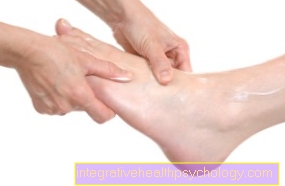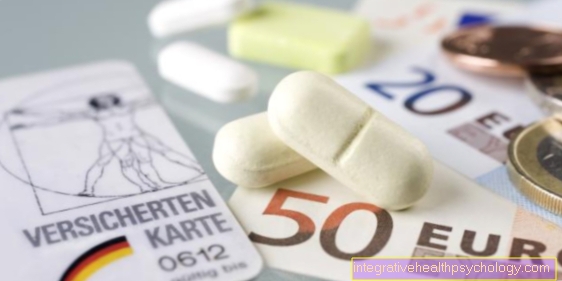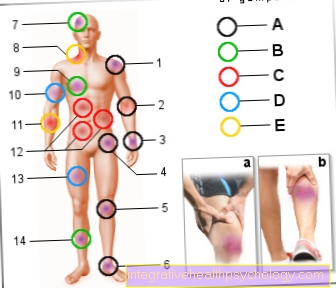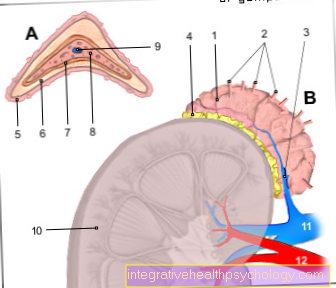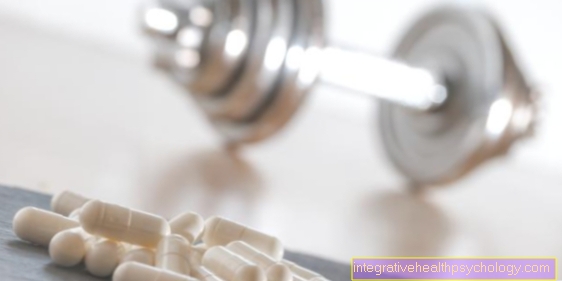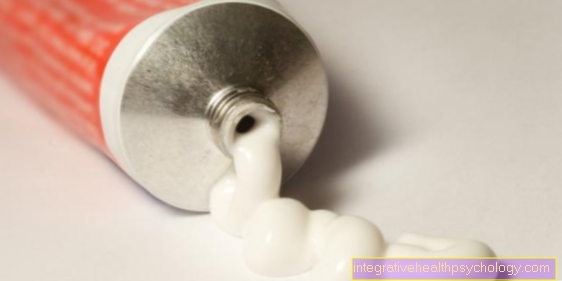Dental plaque
introduction
Bacteria, food residues and mucilage from the saliva form the dental plaque, also called plaque.
This dental plaque settles in the interdental spaces, the pits on the tooth surfaces and especially on the gumline. It is difficult to spot because of its yellowish-gray color.
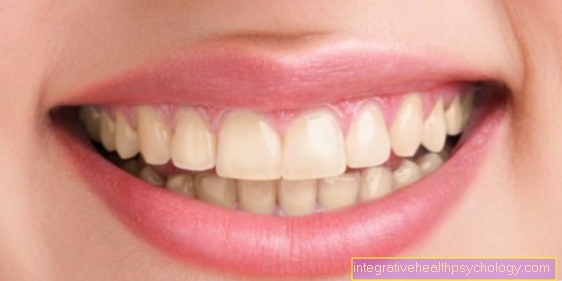
Formation of dental plaque
Bacteria are the basis for the development of dental plaque.
If there is enough water and nutrients, they can stick to the surface of the tooth enamel and form a film. Exactly which bacteria are involved has not yet been clarified. It is believed, however, that the bacterium Fusobacterium nucleatum and other aerobic bacteria are responsible for the initial attachment. Aerobic means that these bacteria need air to survive. Only in the course of biofilm growth do other, even more harmful bacteria appear. These are mostly anaerobic bacteria, which can also survive in deeper plaque layers, as they do not need air to survive.
Due to its tough and sticky consistency, due to the dextrans formed by the bacteria, the plaque cannot be washed away, but can only be removed with a toothbrush and dental floss. The most dangerous components of plaque are sugar-processing bacteria, mainly Streptococcus mutans and anaerobic bacteria such as Actinobacillus actinomycetemcomitans
The sugar-processing bacteria generate aggressive acids and are therefore the cause of tooth decay. In addition, sticky excretions keep the plaque together. The anaerobes attack the gums and, if they are not removed, they invade and destroy the teeth holding apparatus. After a removal of the dental plaque, plaque forms again in a short time, so that teeth brushing has to be done daily after meals.
Read on below: How does tooth decay develop?
Difference Between Plaque and Plaque
Plaque is a sticky, colorless film that adheres to the surface of the tooth. It is increasingly found on the gumline and between the teeth. It is a soft plaque made up of saliva, bacteria and their metabolic products. You can remove it yourself at home with dental floss and a toothbrush.
If the cleaning behavior is poor, however, this film calcifies, which creates solid plaque. This causes tartar and discoloration. Furthermore, it promotes periodontal disease and can only be removed by the dentist with a professional teeth cleaning.
These articles might also interest you: Proper dental care
What are pellicles?
The Pellicle, English Pellicle, forms as a thin coating on the tooth after it has been completely cleaned. This happens within 30 minutes after cleaning is finished. The plaque represents a protective layer for the tooth and is therefore not harmful to the tooth. Not only the tooth is covered, but everything that is in the oral cavity, such as fillings, dentures, gums and the oral mucosa. This protective layer is made from proteins that come from saliva. The pellicle can be removed by brushing your teeth, but - as I said - it is always quickly replaced.
You might also be interested in this topic: Oral hygiene
Bad breath from dental plaque
Bad breath is also called "halitosis" and is caused by several factors. In almost 90% of cases, this forms in the oral cavity. One of the reasons is dental plaque. Dental plaque causes putrefactive processes in the mouth, in which bacteria decompose food residues and produce gases, especially Release sulfur compounds. Protein-containing foods such as milk and fish in particular cause particularly unpleasant smells.
However, if the oral hygiene is poor, dental plaque also causes gingivitis. The tissue breakdown can produce odors which we perceive as unpleasant depending on the degree of the disease. However, there are also problems with the deposits of viruses, bacteria or fungi, which settle in the pits of the tongue and are difficult to remove there.
Read more on the topic:
- Causes of Bad Breath
- How to fight bad breath successfully
Discoloration from dental plaque
In addition to the bacterial plaque, colored deposits also build up on the tooth surfaces.
They are caused by red wine, tea, or some medicines. Brown to black deposits form, which are difficult to remove, especially in heavy smokers. The smoker's toothpastes offered in stores have a high level of abrasiveness thanks to their coarse cleaning material and should therefore not be used too often. It is better to have your teeth cleaned professionally by the dentist.
You might also be interested in this topic: White teeth through home remedies
Correctly remove plaque
The removal of soft dental plaque is done through daily oral hygiene.
The plaque can be removed with a toothbrush and toothpaste. The plaque can be removed from the spaces between the teeth, which are difficult to reach for the toothbrush, with dental floss, interdental brushes or tooth sticks. Caries, gingivitis and periodontitis are prevented by thorough removal of bacterial deposits. If the plaque is not removed, tartar is created, which can only be removed by the dentist.
In theory, plaque could also be removed with antibacterial mouthwashes. However, since the sensitivity of the microorganisms is different, there is a risk that the oral flora is out of balance and the harmful germs may be retained. Chemical plaque control is therefore not recommended. The exception are situations in which normal oral hygiene is not possible. This is the case, for example, when splinting broken jaws.
Read more on the topic:
- This is how you can remove plaque
- Brush your teeth - that's the right way
Plaque remover
Plaque removers are instruments that can be used to remove hard plaque. These are similar to the dentist's instruments, which are called "scalers". These are sharp devices that can be used to "scrape" or scrape the tartar off your teeth. However, this procedure is not entirely safe without experience, because the poor accessibility of the oral cavity with your own hand can quickly slip off and injure your gums.
In addition, you can push the tartar further under the gums and thus cause no more damage. If you exert too much pressure, it can also lead to cracks and scratches in the tooth enamel, which can no longer be repaired. Furthermore, in the case of domestic use, the teeth are not subsequently polished, which is the only means to prevent new deposits. The tooth surface remains rough and the tartar builds up again. Professional removal by an expert is therefore strongly recommended in order to avoid consequential damage.
Find out more about the topic:
- Tartar scratches
- Dental plaque tablets
Home remedies for dental plaque
To remove the soft plaque, toothbrushes and dental floss are the first choice. If handled correctly, the teeth can be completely cleaned. There are several home remedies for harder coverings that promise more or less success depending on the degree of severity. Regular rinsing with hydrogen peroxide after brushing your teeth not only reduces the soft plaque but also bleaches your teeth. However, the H2O2 should be mixed with water so that the teeth are not attacked too much.
When cleaning with the toothbrush itself, you can put baking soda directly on the toothbrush and then brush over the stubborn deposits. However, you should avoid touching healthy tooth enamel as much as possible, as baking soda has very high abrasive properties. You could damage the top layer of enamel and so to speak "clean it away".
Tea tree oil and lemons are also recommended. However, it is healthiest for the teeth to have this removal of the hard plaque carried out by a specialist in the dental office. Because only with the right expertise the teeth will not be damaged and you can enjoy a bright white smile for a long time.
You might also be interested in this topic: How can you remove tartar naturally?
Make dental plaque visible
Although plaque can be felt well when the tongue is brushed over the individual teeth (teeth covered with plaque increasingly feel rough, dull and uneven) it is not always visible to the naked eye. Various preparations (in tablet form or as solutions) can be used to make dental plaque visible. The ingredients of these preparations react with different components of the plaque and in this way take on a specific color. Dental plaque can be easily recognized as such and removed more effectively.
Preparations for making dental plaque visible:
- Plaque detector tablets:
These coloring tablets usually consist of substances that react with certain components of the dental plaque (mostly with protein or sugar residues) and thereby color the teeth on the basis of food coloring. This way of making the dental plaque visible can therefore be used without hesitation, there is no risk of tooth damage or organ damage when swallowing. Most plaque detector tablets are not only able to make plaque visible to the eye, they can also differentiate between old and new deposits. Most manufacturers use a blue dye to show older plaque (older than 48 hours) and a red (or pink) dye to make new plaque visible. The residue can then be easily removed with a toothbrush or with interdental brushes and dental floss leave no residue. - Detector solutions:
The detector solution can be dripped onto a cotton swab or brush and then applied specifically to the tooth surface. These preparations also consist of food coloring and can therefore be used without hesitation, there is no danger to teeth, gums and the digestive tract. - Special mouthwashes
Special mouthwashes for making dental plaque visible are particularly suitable for children, as they are particularly easy to use and already after 30-60 seconds a clear color change in plaque-covered areas. The disadvantage of these mouth rinsing solutions is the fact that it is usually not possible to differentiate between old and fresh plaque. The typical detector mouthwashes only serve as an aid for brushing your teeth.
The advantage compared to plaque detector tablets is the comparatively low price. Both the handling of the solution to make the dental plaque visible and the use of the detector tablets are quite simple. In addition, some manufacturers offer special gels and pastes that make dental plaque based on food coloring visible.
The preparations in gel form are particularly easy and clean to use.
The advantage of this method is the fact that in addition to the distinction between older and new coverings, those areas are also mapped that have a particularly high bacterial load (i.e. high risk of plaque) exhibit.
Read more on the topic: Make dental plaque visible
Coloring tablets
Coloring tablets are a means of improving your own oral hygiene.
The food coloring agent erythrosine stains plaque in the mouth and ensures that the harmful plaque is precisely identified. In the meantime, two-colored tablets are even available, in which the darker color makes the older coating visible. They are particularly suitable for children to check their cleaning. You can show the little ones where they need to be more thorough. However, care should be taken with them, as they can also stain clothes and towels.
You may also be interested in this topic: Dental care for children
What to do if you get plaque despite regularly brushing your teeth?
If plaque builds up frequently despite regular tooth brushing, this can be due to several factors. On the one hand, because dental care at home is not carried out properly and deposits still remain after cleaning.
However, coloring tablets then help to make the remaining plaque visible so that it is easier to remove. On the other hand, the individual saliva composition also determines the formation of tartar. Very mineral-rich saliva accumulates even with good oral care. Then only regular checks and removal by the dentist will help.
Find out more about the topic: Toothbrushing Techniques
What happens if you don't remove the plaque?
If the plaque is not removed, it is converted into tartar through the storage of calcium. Due to its rough surface, it offers an excellent starting point for new plaque.
However, tartar can no longer be removed with a toothbrush, but has to be removed by the dentist using ultrasound. Tartar formation without dental plaque or plaque is not possible. Tartar is not only responsible as a starting point for new plaque, its sharp edges also exert a constant stimulus on the gums, which become inflamed and thus form an entry point for bacteria.
Also read the article on the topic: Removal of tartar
Dental plaque after taking antibiotics
Just like some foods, antibiotics can stain teeth. In most cases, these opacities are reversible, i.e. they can be removed. Even with good cleaning technique, these deposits cannot always be prevented. Amoxicillin, which is often used in dentistry, causes a gray or brown discoloration. With regular dental care, professional tooth cleaning and polishing, your teeth will shine again in no time.
However, this is not the case with tetracyclines: in the presence of calcium, these antibiotics form a certain substance which can penetrate the teeth during the growth phase (childhood) and then discolor them brown. Therefore, this active ingredient is absolutely contraindicated in the development phase and during pregnancy and must no longer be used.
What is the oral flora?
There are innumerable microorganisms in the oral cavity that feel extremely comfortable in the moist and warm oral cavity environment. In addition to various types of bacteria, these are also fungi, yeasts and amoebas and flagellates.
Both oxygen-loving bacteria (Aerobes) as well as bacteria that can do without oxygen (Anaerobes) and those that are viable either with or without oxygen are found in enormous numbers in the coverings. This mixture is normally in a balanced state in the oral cavity and thus represents the normal oral flora. It contains pathogenic and benign microorganisms that keep each other in check. But if the balance is disturbed, it can lead to diseases.
Summary
Dental plaque is constantly being regenerated and contains, among other things, bacteria, the metabolic products of which attack both the tooth enamel and the gums. Daily cleaning of the teeth with a toothbrush, toothpaste and dental floss is therefore necessary. Tartar can only be removed by the dentist.


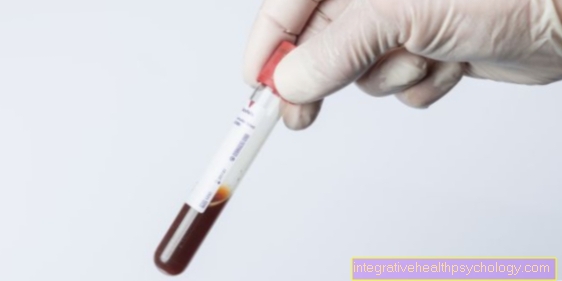



.jpg)
